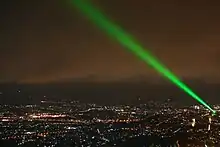Horst H. Baumann | |
|---|---|
| Born | 19 June 1934 Aachen, Nazi Germany |
| Died | 24 May 2019 (aged 84) |
| Nationality | German |
| Occupation | Architect |

Horst H. Baumann (19 June 1934 Aachen – 24 May 2019) was a German architect, designer, light artist,[1] and photographer.[2][3] He was best known for designing Rheinturm Düsseldorf, in Düsseldorf, Germany.[4][5][6]
Life
He studied metallurgical engineering from 1954 to 1957 and from 1972 to 1974 at the RWTH Aachen, and from 1994 to 2004 at the Heinrich-Heine University in Düsseldorf. He worked as a photographer and designer from 1957 to 2019, and from 1966 to 2019 as a lighting artist. In 1963–1964, he was a visiting lecturer at the Hochschule für Gestaltung in Ulm. In 1977, he took part in documenta 6 in Kassel, where he installed, with Peter Hertha, the first permanent laser sculpture in the world.
Other installations include the Rheinturm in Düsseldorf (1982), the Neonskulptur "Pass the Cross" in Bielefeld-Sennestadt (1988), and the light remodeled at the Rheinturm Düsseldorf 2003.
His work has been shown internationally, including in the Museum of Modern Art, in New York City in 1965,[7] and in 1967 and 1969 in the Biennale des Jeunes in Paris.[8]
He died on 24 May 2019, aged 84.[9]
References
- ↑ "World Trade Center Memorial Lightscape". Archived from the original on 2010-09-01. Retrieved 2010-03-13.
- ↑ "Luminous-Lint – Photographer – Horst H. Baumann". www.luminous-lint.com.
- ↑ "Ars Electronica Katalogartikel". 90.146.8.18.
- ↑ "The expat guide for international residents".
- ↑ "arkitectoniq". arkitectoniq.blogspot.com.
- ↑ "Lichtzeitpegel Rheinturm - Düsseldorf". Archived from the original on 2009-04-15. Retrieved 2010-03-13.
- ↑ "Erevista.ro". 20 May 2023.
- ↑ "Archived copy". Archived from the original on 2011-07-25. Retrieved 2010-03-13.
{{cite web}}: CS1 maint: archived copy as title (link) - ↑ Libuda, Klas (28 May 2019). "Nachruf: Entwickler der Uhr am Rheinturm gestorben". RP ONLINE (in German). Retrieved 2019-05-29.
External links